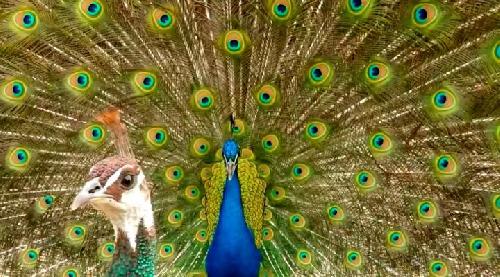As male peacocks shake their long feathers in courtship, the iridescent eyespots remain nearly stationary and captivate females, according a study published April 27, 2016, in the open-access journal PLOS ONE by Roslyn Dakin from the University of British Columbia, Canada, and colleagues.
Courtship displays can signal the relative physical quality of males vying for females. A male peacock, for example, entices peahens by raising and vibrating his long train feathers. The vibrations both make the feathers rattle and make the brightly colored eyespots appear to hover motionless against an oscillating iridescent background. Males with eyespots that are the most iridescent win most of the matings.
In this study, the researchers used high-speed video to analyze the "train-rattling" movements of vibrating train and tail feathers in 14 adult peacocks, and measured the vibrations of individual feathers in the lab. They found that displaying peacocks vibrate their feathers at or near resonance, giving the train the greatest vibrational amplitude and suggesting that these courtship displays may be energetically efficient.
 This is a male peacock courting a female peacock. Credit: Image Credit: Roslyn Dakin PLOS ONE e0152759
This is a male peacock courting a female peacock. Credit: Image Credit: Roslyn Dakin PLOS ONE e0152759
Scanning electron microscopy then revealed how the eyespots stay so still during displays: Dakin and colleagues found that eyespot barbs are locked together with microhooks much like those on flight feathers. This gives each eyespot greater density than the surrounding loose barbs, keeping it essentially in place as the loose barbs shimmer in the background.
In addition, their findings showed that the longer the train feathers, the faster the males shook their feathers during courtship displays, requiring more muscular effort. This suggests that the dynamics of feather vibrations could also signal male muscle power to choosy females.
Suzanne Kane, a co-author of the study, adds: "Charles Darwin observed that peacocks vibrate their feathers during courtship, but it took this multidisciplinary team of scientists to characterize the dynamics of this behavior."
source: PLOS